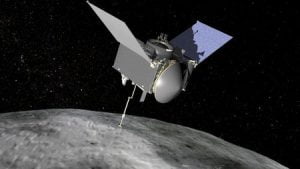NASA effectively dispatched a space test destined for the space rock Bennu Thursday, September 8 at 7:05 p.m. ET.
OSIRIS-REx, short for Origins, Spectral Interpretation, Resource Identification-Regolith Explorer, ought to achieve the close Earth space rock by 2018. “Close” is a relative term here, since Bennu is around 121 million miles away.
NASA researchers are trusting the almost $1 billion mission will help them disentangle how life started on Earth, how the close planetary system shaped, and how to shield our planet from stray space rocks like Bennu.

The Origins, Spectral Interpretation, Resource Identification, Security-Regolith Explorer (OSIRIS-REx) spacecraft which will travel to the near-Earth asteroid Bennu and bring a sample back to Earth for study into the origins of life. NASA/Handout via Reuters
The 190-foot tall Atlas V rocket dispatched right on time in immaculate climate conditions from Cape Canaveral, Florida on Thursday, destined for Bennu:
When OSIRIS-REx achieves the space rock is the point at which the genuine nail-gnawing part of the mission starts.
It would be excessively precarious, making it impossible to arrive on the space rock, so the space test will connect its 10-foot automated arm to jab Bennu and catch pretty much 2 ounces of dust. Following a two year travel, this example gathering will take only five seconds.
OSIRIS-REx will store the specimen for its arrival excursion to Earth. In 2023, simply the holder holding the specimen will re-enter the climate and tumble sensible, helped by a parachute. NASA anticipates that it will arrive in Utah, and researchers can start examining the specimen.
This dispatch happened precisely a week after SpaceX’s arranged dispatch of a satellite for Facebook detonated on the platform. Fortunately, the blast was at an area not far off from NASA’s platform for the space rock mission, so the office didn’t confront any deferrals.






